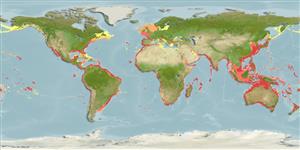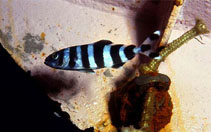Add your observation in Fish Watcher
| Native range | All suitable habitat | Point map | Year 2050 |

|
| This map was computer-generated and has not yet been reviewed. |
| Naucrates ductor AquaMaps Data sources: GBIF OBIS |
Upload your photos and videos
Pictures | Videos | Sounds | Google imageNaucrates ductor
Picture by Luquet, D.
Pictures | Videos | Sounds | Google imageNaucrates ductor
Picture by Luquet, D.
Italy country information
Common names:
Fanfalu, Fanfano, Fanfano
Occurrence: native
Salinity: marine
Abundance: | Ref:
Importance: | Ref:
Aquaculture: | Ref:
Regulations: | Ref:
Uses: no uses
Comments:
National Checklist:
Country Information: https://www.cia.gov/library/publications/resources/the-world-factbook/geos/it.html
National Fisheries Authority:
Occurrences: Occurrences Point map
Main Ref: Berry, F.H. and W.F. Smith-Vaniz, 1978
National Database: ICTIMED
Occurrence: native
Salinity: marine
Abundance: | Ref:
Importance: | Ref:
Aquaculture: | Ref:
Regulations: | Ref:
Uses: no uses
Comments:
National Checklist:
Country Information: https://www.cia.gov/library/publications/resources/the-world-factbook/geos/it.html
National Fisheries Authority:
Occurrences: Occurrences Point map
Main Ref: Berry, F.H. and W.F. Smith-Vaniz, 1978
National Database: ICTIMED
Common names from other countries
Classification / Names ชื่อสามัญ | ชื่อพ้อง | Catalog of Fishes(สกุล, ชนิด) | ITIS | CoL | WoRMS | Cloffa
> Carangiformes (Jacks) > Carangidae (Jacks and pompanos) > Naucratinae
Etymology: Naucrates: Greek, naykrates, -es, -es = supremacy in the sea (Ref. 45335).
More on author: Linnaeus.
Etymology: Naucrates: Greek, naykrates, -es, -es = supremacy in the sea (Ref. 45335).
More on author: Linnaeus.
Environment: milieu / climate zone / depth range / distribution range นิเวศวิทยา
เกี่ยวกับทะเล,น้ำเค็ม เกี่ยวกับหินโสโครก; ระดับความลึก 0 - 300 m (Ref. 86942). Subtropical; 61°N - 43°S, 180°W - 180°E
การแพร่กระจาย ประเทศต่างๆ | พื้นที่จำแนกตาม FAO | ระบบนิเวศหลายระบบ | การปรากฏขึ้น,การเกิดขึ้น,พบ | Point map | การแนะนำ | Faunafri
Circumtropical in tropical seas. Western Atlantic: Nova Scotia, Canada to Argentina (Ref. 7251). Eastern Atlantic: British Isles (rare vagrant), Norway and Bay of Biscay to Namibia, including the Mediterranean and Canary Islands. Eastern Pacific: Vancouver Island (British Columbia, Canada) to the Galapagos Islands (Ref. 2850) and Chile (Ref. 115205). Common throughout the Indian Ocean (Ref. 3197).
ขนาด / น้ำหนัก / Age
Maturity: Lm ? range ? - ? cm
Max length : 70.0 cm TL เพศผู้/กระเทย; (Ref. 5288); common length : 40.0 cm TL เพศผู้/กระเทย; (Ref. 9626)
Max length : 70.0 cm TL เพศผู้/กระเทย; (Ref. 5288); common length : 40.0 cm TL เพศผู้/กระเทย; (Ref. 9626)
Short description เครื่องมือที่ใช้ในการแยกชนิดสัตว์,สิ่งมีชีวิตออกจากกัน | สัณฐานวิทยา | ความยาวต่างๆ
เงี่ยงครีบหลัง (รวม) : 5 - 6; ก้านครีบอ่อนที่หาง (รวม) : 25 - 29; เงี่ยงครีบก้น: 3; ก้านครีบอ่อนที่ก้น: 15 - 17. Body elongate, slender, and not strongly compressed; posterior end of upper jaw located at anterior rim of eye; dorsal fin with 4 or 5 spines followed by another spine and 25 to 29 soft rays (IV-V+I 25-29); lateral line without scutes; caudal peduncle with well developed fleshy keels and with dorsal and ventral peduncular fossae (Ref. 55763). Body dark to pale bluish, with 6-7 broad, dark bars; white tips on caudal lobes and on second dorsal and anal lobes (Ref. 3197).
Oceanic species with a semi-obligate commensal relationship with sharks, rays, other bony fishes and turtles (Ref. 5217). Young are usually associated with jellyfish and drifting seaweed (Ref. 2850, 9563). Feed on scraps of host's left over, parasites and excrement; also on small fishes and invertebrates (Ref. 5288). Eggs are pelagic (Ref. 4233). Marketed fresh and salted or dried (Ref. 9283). Captured at the surface using hand nets (Ref. 26165).
Life cycle and mating behavior วัยเจริญพันธุ์ | การสืบพันธุ์ | การวางไข่ | เซลสืบพันธ์ของเพศเมีย(ไข่) | ความดกของไข่ | ตัวอ่อน
Main reference
Upload your references | อ้างอิง | ผู้ประสานงาน : Smith-Vaniz, William F. | ผู้ร่วมมือ
Smith-Vaniz, W.F., J.-C. Quéro and M. Desoutter, 1990. Carangidae. p. 729-755. In J.C. Quero, J.C. Hureau, C. Karrer, A. Post and L. Saldanha (eds.) Check-list of the fishes of the eastern tropical Atlantic (CLOFETA). JNICT, Lisbon; SEI, Paris; and UNESCO, Paris. Vol. 2. (Ref. 7097)
IUCN Red List Status (Ref. 130435: Version 2024-2)
Least Concern (LC) ; Date assessed: 07 November 2013
Threat to humans
Harmless
Human uses
การประมง: มีการค้าเพียงเล็กน้อย; การตกปลาเป็นกีฬา: ใช่; สถานที่แสดงสัตว์และพืชน้ำ: สถานแสดงสัตว์น้ำของรัฐ
FAO(การประมง: การผลิต; publication : search) | FishSource | ทะเลรอบๆเรา
ข้อมูลเพิ่มเติม
Population dynamics
Growth parameters
Max. ages / sizes
Length-weight rel.
Length-length rel.
Length-frequencies
Mass conversion
การทดแทนที่
อุดมสมบรูณ์
Growth parameters
Max. ages / sizes
Length-weight rel.
Length-length rel.
Length-frequencies
Mass conversion
การทดแทนที่
อุดมสมบรูณ์
Life cycle
การสืบพันธุ์
วัยเจริญพันธุ์
ความดกของไข่
การวางไข่
Spawning aggregations
เซลสืบพันธ์ของเพศเมีย(ไข่)
Egg development
ตัวอ่อน
พลวัตของสัตว์น้ำวัยอ่อน
การสืบพันธุ์
วัยเจริญพันธุ์
ความดกของไข่
การวางไข่
Spawning aggregations
เซลสืบพันธ์ของเพศเมีย(ไข่)
Egg development
ตัวอ่อน
พลวัตของสัตว์น้ำวัยอ่อน
Distribution
ประเทศต่างๆ
พื้นที่จำแนกตาม FAO
ระบบนิเวศหลายระบบ
การปรากฏขึ้น,การเกิดขึ้น,พบ
การแนะนำ
BRUVS - Videos
ประเทศต่างๆ
พื้นที่จำแนกตาม FAO
ระบบนิเวศหลายระบบ
การปรากฏขึ้น,การเกิดขึ้น,พบ
การแนะนำ
BRUVS - Videos
Physiology
Body composition
Nutrients
การใช้ออกซิเจน
รูปแบบการว่ายน้ำ
ระดับความเร็วในการว่ายน้ำ
Visual pigments
Fish sound
Diseases & Parasites
Toxicity (LC50s)
Body composition
Nutrients
การใช้ออกซิเจน
รูปแบบการว่ายน้ำ
ระดับความเร็วในการว่ายน้ำ
Visual pigments
Fish sound
Diseases & Parasites
Toxicity (LC50s)
Genetics
พันธุศาสตร์
Heterozygosity
อัตราพันธุกรรม
พันธุศาสตร์
Heterozygosity
อัตราพันธุกรรม
Human related
Aquaculture systems
ประวัติการเพาะเลี้ยงสัตว์น้ำ
สายพันธุ์
Ciguatera cases
Stamps, coins, misc.
Aquaculture systems
ประวัติการเพาะเลี้ยงสัตว์น้ำ
สายพันธุ์
Ciguatera cases
Stamps, coins, misc.
เครื่องมือ
Bio-Quiz | E-book | คู่มือภาคสนาม | เครื่องมือที่ใช้ในการแยกชนิดสัตว์,สิ่งมีชีวิตออกจากกัน | ผู้มีความชำนาญในเรื่องความถี่ของความยาว | เครื่องมือในการศึกษาชีวประวัติ | ตำแหน่งบนแผนที่ | Classification Tree
| Catch-MSY |
Special reports
Download XML
แหล่งที่มาจากอินเตอร์เน็ต
Aquatic Commons | BHL | Cloffa | Websites from users | Check FishWatcher | CISTI | Catalog of Fishes(สกุล, ชนิด) | DiscoverLife | DORIS | ECOTOX | Faunafri | Fishtrace | GenBank(genome, nucleotide) | GloBI | GOBASE | | Google Books | Google Scholar | Google | IGFA World Record | MitoFish | ฐานข้อมูลแห่งชาติ | OsteoBase(skull, spine) | Otolith Atlas of Taiwan Fishes | สถานแสดงสัตว์น้ำของรัฐ | PubMed | Reef Life Survey | Scirus | SeaLifeBase | แผนภูมิชีวิตแบบต้นไม้ | Wikipedia(Go, ค้นหา) | World Records Freshwater Fishing | บันทึกทางด้านสัตววิทยา
Estimates based on models
Preferred temperature (Ref. 115969): 7.9 - 28.1, mean 20.9 (based on 3025 cells).
Phylogenetic diversity index (Ref. 82804): PD50 = 1.0000 [Uniqueness, from 0.5 = low to 2.0 = high].
Bayesian length-weight: a=0.01413 (0.00659 - 0.03029), b=2.93 (2.74 - 3.12), in cm Total Length, based on LWR estimates for this species & (Sub)family-body (Ref. 93245).
ระดับชั้นอาหาร (Ref. 69278): 3.4 ±0.43 se; based on food items.
ความสามารถในการกลับคืนสู่ปกติ (Ref. 120179): ขนาดกลาง, เวลาต่ำสุดที่จะทำให้ประชากรเพิ่มขึ้นเป็น 2 เท่าใช้เวลา 1.4 - 4.4 ปี (Preliminary K or Fecundity.).
Fishing Vulnerability (Ref. 59153): Moderate to high vulnerability (48 of 100).




